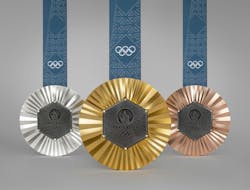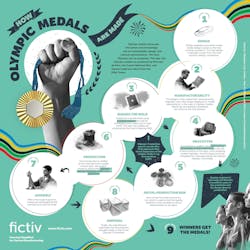Designing a Winning Medal: What’s Behind the Flub of This Year’s Bronze Medals?
The tradition of awarding highly regarded medals to Olympic winners was slightly tarnished this year, following reports from bronze medal athletes about their medals losing luster within days of receipt.
While the deterioration could be the result of any number of causes, the Paris 2024 Olympic organizers have reported that they are working with the Monnaie de Paris, the institution tasked with the production and quality control of the medals, and the National Olympic Committee to appraise the cause of the damage.
Keep in mind that these coveted bronze medals aren’t made of bronze, per se. “This year’s bronze medal is actually 97% copper, 2.5% zinc and a half a percent tin,” said Tessa Axsom, director of CNC, Fictiv, a San Fransisco-based company that specializes in custom manufacturing of mechanical parts and processes.
READ MORE: Q&A: Enhancing Performance and Versatility with Advanced 3D Printing Materials
Copper oxidation is likely the cause, according to Axsom.
Several news outlets reported that the discoloration and chipping was due to sustainability practices, “but that is not true,” pointed out Axsom. “Using recycled metals to make the metals is not what’s causing this. Copper oxidation is natural, and it reaches stability when it forms oxides and salts. So, when you have sweaty athletes wearing these metals, getting salt on them, you’re going to get oxidation. The metal should have been protectively coated.”
Basic Copper Reaction
Oxidation is a form of metallic corrosion and occurs during a chemical reaction when oxygen is present on the metal’s surface.
The first phase in oxidation, Axsom explained, is a red or dull red color, but it could further discolor into a blackish, brownish hue and eventually the blue-green and purple patina, depending on the environment that the copper is exposed to.
The medals should have been coated with a clear protective film to prevent discoloration and to provide a barrier between the copper and the atmosphere. An example of this protective layer would be a protective coating such as Everbrite. Axsom said that it could be the case that a protective coating was applied, but that the medals might have had some residual contaminants that prevented strong adhesion of the coating.
Axsom theorized that the chipping could be due to the brittle nature of copper-oxide powders of poly-crystals. This further enhances the theory of copper oxidation and explains why they seem to be chipping, she said.
Investigating the Cause of Corrosion
What would Axsom do if she was investigating the cause of the discoloration? She would collect a medal, cross-section it, inspect it under a scanning electron microscope and perform energy dispersive spectroscopy to determine the discolored areas’ composition.
That would help determine how to reprocess the medals, said Axsom, a mechanical engineer who has specialized knowledge of metallurgy and material science, as well as design engineering for thermal management systems for aerospace.
“Perhaps they could be cleaned and recoated with a protective coating, or perhaps they would decide to melt these down and make new medals,” she added. “Either way, figuring out what’s occurring would help to provide the corrective actions to prevent recurrence, which is important in continuous improvement and when you have an issue that causes a failure of a part.”
Olympic Medal Design and Process
Every design process begins with an idea. “For this year’s Olympic medals, the organizers had the vision of creating something with Paris in mind, of course, and there’s nothing more iconic than the Eiffel Tower,” said Axsom. “They went back to the archives—and this is similar to what a design engineer would do when they’re designing a new product—to see what had been done before, and what references they had that could provide insight for the future design.”
This year’s Olympic medal design includes a piece of metal taken from the original Eiffel Tower. The metal pieces are derived from metallic elements permanently removed through renovations and conserved in the process. The Eiffel Tower Operating Company approved the use of these coveted pieces of French history in the manufacture pf the Olympic medals.
The Olympic and Paralympic medals have a unified design on one side, which is encrusted with the Eiffel Tower iron. The reverse side of the Olympic medal is adorned with renderings of the goddess of victory Athena Nike, the Panathenaic Stadium, the Acropolis of Athens and the Eiffel Tower.
READ MORE: The Emerging Role of the Product Designer
The back of the Paralympic medals features a graphic representation of the Eiffel Tower viewed from below. The words “Paris” and “2024” at the base of the tower are inscribed in universal Braille, the symbolic language of accessibility and honoring French inventor, Louis Braille. Dashes engraved on the edge allow visually impaired athletes to distinguish between the medals: I for gold, II for silver and III for bronze.
“In this case, the metals don’t really have to function; they’re not going to be seeing a lot of wear or weight or repeated cycles of use, but they have to look nice,” explained Axsom. “This process is unique because they called on LVMH (Louis Vuitton Moet Hennessy) jewelry and watchmaking designer Chaumet.”
Axsom envisaged a design engineer would seek the help of an industrial engineer and artists to design aspects that are heavily aesthetic. “I’m sure that they also had some mechanical engineers and some experts from their jewelry making department weigh in on the manufacturability of the design,” Axsom surmised. “That is something that Fictiv does well for our customers.
“You can upload a 3D model and the [luxury jeweler] Chaumet could have uploaded a version of their design and gotten manufacturability feedback for free with Fictiv’s AI-driven DFM feedback on the platform,” she added.
Rigorous Testing Process
Axsom said that each medal would have been heavily scrutinized for its aesthetics and composition and would be subjected to environmental testing. “The Olympic Committee sets forth requirements for the weight of each alloy based off each metal that’s contained in each alloy,” she said.
A likely process, as outlined by Axsom, consists of the following: They would probably use X-ray fluorescence to determine the composition or purity of certain metals. In addition, they would conduct visual inspections via the naked eye and microscopes. They might weigh the metals, performing process conformity testing. They might test the chemical baths used to clean the metals after production, followed by cleaning and rinsing.
For the clear coating or the sealant, environmental testing would hopefully be conducted, including destructive or non-destructive testing like salt spray or wear resistance. In this case, maybe UV light exposure testing could be considered.
Corrective Action is Required
Axsom expressed one concern about the fact that the task of designing the medal was awarded to a luxury jeweler who may or may not have fully considered the environmental conditions. “These are athletes—they’re not people going to a ball, or a fancy dinner,” she said. “They are going to have salt water or sweat on them.
“I just wonder if perhaps the medals weren’t protected enough in the first place, Axsom surmised. “This is something that they probably wouldn’t have noticed if they weren’t subjecting these medals to the actual environment during the quality control process.”
Whether there would be enough time to take corrective action before the bronze medals are awarded to athletes during the Paralympic games (Aug. 28–Sept. 8) remains to be seen. The Paralympic program lasts 11 days and 4,400 athletes from around the world will compete in 22 Paralympic sports.
READ MORE: 5 Reasons Metallurgy is Essential in Material Selection for Harsh Environments
On this point, Axsom’s optimism prevailed: “I would hope that they would either re-clean and re-coat the medals, or they could start over with a new batch, and ensure that the new batch is cleaned and coated with a protective coating to prevent oxidation from occurring. And then check the robustness of that coating.
“I would probably try out a few different coatings, different chemistries, and expose all of those to a significant salt spray test and perhaps even some acids as well, to see which coating stood up the best,” she added. “And that’s what I would use for the next batch of Olympic bronze medals.”
Editor’s Note: Machine Design’s WISE (Workers in Science and Engineering) hub compiles our coverage of workplace issues affecting the engineering field, in addition to contributions from equity seeking groups and subject matter experts within various subdisciplines.
About the Author

Rehana Begg
Editor-in-Chief, Machine Design
As Machine Design’s content lead, Rehana Begg is tasked with elevating the voice of the design and multi-disciplinary engineer in the face of digital transformation and engineering innovation. Begg has more than 24 years of editorial experience and has spent the past decade in the trenches of industrial manufacturing, focusing on new technologies, manufacturing innovation and business. Her B2B career has taken her from corporate boardrooms to plant floors and underground mining stopes, covering everything from automation & IIoT, robotics, mechanical design and additive manufacturing to plant operations, maintenance, reliability and continuous improvement. Begg holds an MBA, a Master of Journalism degree, and a BA (Hons.) in Political Science. She is committed to lifelong learning and feeds her passion for innovation in publishing, transparent science and clear communication by attending relevant conferences and seminars/workshops.
Follow Rehana Begg via the following social media handles:
X: @rehanabegg
LinkedIn: @rehanabegg and @MachineDesign




